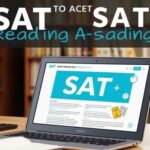The SAT is a critical milestone for students aiming to pursue higher education. With the transition to the Digital SAT, the test format has evolved, and so have the strategies to ace it. The Reading and Writing section is one of the most challenging parts of the exam, requiring strong comprehension, analytical, and time-management skills.
In this guide, we’ll break down everything you need to know to prepare for the Digital SAT Reading Passage, including actionable strategies, resources, and tips to maximize your score. Whether you’re just starting your prep or fine-tuning your skills, this article will help you master the reading section and achieve your target score.
Understanding the Digital SAT Reading Passage: A Comprehensive Guide
Before diving into the preparation for the Digital SAT, it’s crucial to understand the structure, format, and strategies needed to succeed in the Reading Passage section. The SAT is an essential step for students aiming to attend college, and mastering the reading component can significantly improve your overall score. Let’s break down the Digital SAT Reading section in detail, providing an in-depth look at how the test is structured, what to expect, and how to effectively prepare for each aspect.
Format of the Digital SAT Reading and Writing Section
The Reading and Writing section of the Digital SAT is broken into two modules, each lasting 32 minutes. This means that you’ll have a total of 64 minutes to answer 54 questions. The passages in this section are shorter compared to traditional SAT passages, ranging from 25 to 150 words, with each passage paired with a single question. Here’s a breakdown of the section’s format:
- Two 32-Minute Modules: Each module contains 27 questions, so you’ll answer a total of 54 questions.
- Shorter Passages: The passages are relatively short, and each one is paired with one question.
Types of Passages You’ll Encounter
The Reading Passage section includes various passage types that reflect the breadth of reading materials you may encounter in college courses. These passage types include:
- Literature: This category consists of excerpts from novels, short stories, or poetry. These texts often require you to analyze themes, characters, and narrative elements.
- Historical Documents: Foundational texts or speeches such as the U.S. Constitution or Martin Luther King Jr.’s speeches fall into this category. These documents require an understanding of their historical context.
- Social Sciences: Passages in this category discuss topics like psychology, sociology, or economics. These passages may involve analyzing data or understanding societal behaviors.
- Natural Sciences: Texts on topics such as biology, chemistry, or physics are typical here. These passages might require you to interpret scientific information or understand experimental findings.
Question Types and How to Approach Them
The questions in the Digital SAT Reading section can be broadly categorized into different types, each requiring its own approach. Here’s a deeper look at each question type:
- Main Idea Questions: These ask you to identify the central theme or purpose of a passage.
- Strategy: Focus on the first and last sentences of the passage, as they often encapsulate the main idea. Avoid answers that are too specific or irrelevant to the general theme of the passage.
- Detail-Oriented Questions: These questions focus on locating specific information within the passage.
- Strategy: Use the search function (if available), or manually scan for keywords. Pay attention to transitional words such as “however” or “for example,” which often signal important details.
- Vocabulary in Context Questions: These ask you to determine the meaning of a word based on how it’s used in the passage.
- Strategy: Read the surrounding sentences to understand the word’s meaning in context. Then, substitute the answer choices into the sentence to see which one fits best.
- Inference Questions: These require you to draw conclusions based on information that is not explicitly stated in the text.
- Strategy: Look for subtle clues or implied meaning in the passage. Be careful not to choose answers that make assumptions not supported by the text.
- Evidence-Based Questions: These questions ask you to support your answer with specific lines or parts of the passage.
- Strategy: Identify lines that directly support your answer to the previous question. Ensure that the evidence you select aligns with the specific question asked.
Step-by-Step Preparation Plan for the Digital SAT Reading Passage
To succeed on the Digital SAT Reading Passage section, follow a strategic and structured preparation plan. Here’s how you can break down your preparation:
1. Familiarize Yourself with the Digital Format
Since the Digital SAT is administered on a computer or tablet, it’s important to familiarize yourself with the digital interface. Practice using the official Bluebook™ app, which simulates the digital testing environment. Additionally, focus on:
- Practice Navigation: Learn how to highlight text, flag questions for review, and use the built-in tools available during the test.
- Time Management: The 32-minute time limit per module can feel tight, so practice managing your time effectively.
2. Build Strong Reading Comprehension Skills
Reading comprehension is the cornerstone of success in the SAT Reading section. To improve your comprehension:
- Read Actively: Practice reading passages with a specific purpose in mind. Focus on identifying the main idea, the author’s tone, and the evidence presented.
- Expand Your Reading List: Diversify your reading materials to include scientific articles, historical texts, and literary works. This will prepare you for different writing styles and content areas.
- Summarize Passages: After reading a passage, summarize it in a sentence or two. This will help solidify your understanding of the main points.
3. Master Question-Specific Strategies
Each question type requires a unique strategy. Here’s how to approach each one:
- Main Idea: Focus on the passage’s introduction and conclusion for clues to the central theme.
- Detail-Oriented: Utilize the search function to find relevant terms, and pay attention to signal words.
- Vocabulary in Context: Understand how a word is used within the passage by analyzing the surrounding sentences.
- Inference: Look for hints within the passage that suggest meaning beyond the words on the page.
- Evidence-Based: Ensure the evidence you cite directly supports the claim made in the previous question.
4. Develop Time-Management Skills
Since each module lasts only 32 minutes, it’s critical to develop efficient time-management strategies:
- Pace Yourself: Aim for about 1 to 1.5 minutes per question to maintain a steady pace.
- Flag Difficult Questions: If you’re stuck on a question, flag it and return to it later.
- Prioritize Easier Questions: Start with questions that seem more straightforward to build confidence and save time for harder ones.
5. Practice with High-Quality Resources
Use the right resources to prepare effectively for the SAT. Here are some top recommendations:
- Official SAT Practice Tests: These are available on the College Board website and provide the most accurate representation of the test.
- Khan Academy: A trusted partner with the College Board, Khan Academy offers free personalized SAT practice.
- Third-Party Prep Books: Look for prep books specifically designed for the Digital SAT format, which offer focused strategies and practice questions.
6. Analyze Your Mistakes
Reviewing your practice tests is just as important as taking them. Make sure to:
- Identify Patterns: Look for recurring mistakes, such as struggling with certain question types or specific content areas.
- Understand Why: For every incorrect answer, analyze why it was wrong and learn how to avoid similar errors in the future.
- Track Progress: Keep track of your practice scores and progress to stay motivated.
7. Build Vocabulary and Grammar Skills
Though the Digital SAT doesn’t directly test vocabulary, having a solid grasp of language will help you better understand the passages:
- Learn SAT Words: Focus on learning high-frequency words that often appear in SAT passages.
- Review Grammar Rules: Study concepts such as sentence structure, punctuation, and subject-verb agreement to improve overall reading comprehension.
8. Simulate Test-Day Conditions
To reduce test anxiety, replicate test-day conditions during your practice sessions:
- Set a Timer: Practice under timed conditions to simulate the pressure of the actual exam.
- Eliminate Distractions: Find a quiet space where you can focus entirely on your practice test.
- Take Breaks: Follow the official SAT break schedule to build stamina and practice managing your time effectively.
Top Tips for Success on the Digital SAT Reading Passage
- Stay Calm and Focused: Test anxiety can hinder your performance. Practice mindfulness techniques to stay calm and composed.
- Read the Questions First: Skim the questions before reading the passage to focus on what information to look for.
- Use Process of Elimination: Narrow down answer choices by eliminating obviously incorrect answers.
- Trust Your Instincts: If you’re unsure about an answer, go with your first instinct—it’s often correct.
- Consistency is Key: Regular practice is essential for building confidence and improving your skills.
Common Mistakes to Avoid
- Overthinking Questions: Don’t spend too much time on a single question. If you’re stuck, flag it and move on.
- Ignoring Context: Always consider the context of the passage when answering questions.
- Rushing Through Passages: Time is limited, but rushing can lead to careless mistakes. Strive for a balance between speed and accuracy.
Final Thoughts
Preparing for the Digital SAT Reading Passage requires a combination of strategic planning, consistent practice, and a deep understanding of the test format. By following the steps outlined in this guide, you’ll be well-equipped to tackle the Reading and Writing section with confidence.
Remember, success on the SAT isn’t just about intelligence—it’s about preparation and perseverance. Start early, stay focused, and trust in your ability to improve. With the right mindset and resources, you can achieve your target score and take a significant step toward your academic goals.









